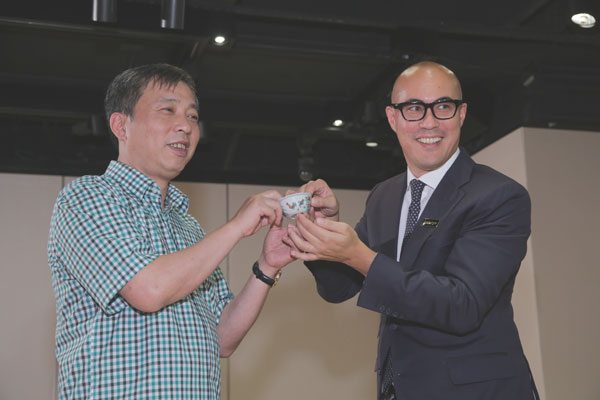

Liu Yiqian (left) receives the Chenghua chicken cup in Hong Kong. Photo provided to China Daily.
Liu Yiqian has yet to announce when the chicken cup - worth $36 million - will go on display at his private Long Museum, but the public has already seen plenty of the valuable porcelain.
Pictures of the Shanghainese millionaire happily sipping tea from the "holy grail" of Chinese ceramics have been widely published in China. He has been criticized for being "shallow" or "showing off", but others say he has every right to drink from the cup, after all, he paid dearly for it.
Liu, 51, ranked 200th on Forbes magazine's rich list in 2013. He bought the valuable cup by bidding over telephone at a Sotheby's auction in April, setting an auction world record for Chinese porcelain.
On July 19, Liu flew home to Shanghai with the cup after completing the transaction at Sotheby's in Hong Kong. The cup is stored in a bonded warehouse in the city's Xuhui district. It will be exhibited at the Long Museum later this year.
According to the auction house, Liu swiped his credit card 24 times to make the payment on July 18. It was reported that he will receive American Express Centurion card's reward points equivalent to frequent flyer's mileage of more than 28 million miles.
He drank tea from the valuable cup right after completing the transaction. He excitedly told the press that "emperors and their concubines may have drunk from it. I want nothing more than a touch of the magic breath".
The 8.2-centimeter-wide cup bears the image of a rooster and hen tending to their chicks. An estimated 600 years old, the cup is an example of the peak of ceramic art during the reign of Chenghua (1465-1487).
The royal families of the Ming Dynasty (1368-1644) favored these chicken cups not only because they used the latest doucai technique, but also for the patterns that signify harmonious country life.
Doucai literally means "colors which fit together", and it was difficult to achieve in the 15th century because the blue color had to be done underglaze, while other colors overglaze, and no satisfactory overglaze blue enamel was available at the time.
Nicholas Chow, deputy chairman of Sotheby's Asia, recounted the first time he came into close contact with a Chenghua chicken cup more than 10 years ago. He was told to remove the cup from the cabinet to show to a client.
Chow tells Chinese media that he was greatly moved by the trust from his boss at the time, and "had never been so nervous" walking about 15 meters across the hall floored with marble.
He calls the piece "the holy grail of Chinese art", and says "there is no more legendary object in the history of Chinese porcelain".
He also points out that it was the most imitated piece of artwork in China, with "tens of thousands, perhaps hundreds of thousands of copies going around in China".
Search for the Chinese characters "ji gang bei" (chicken cup) on Taobao.com, China's premier online marketplace, and you will find more than 20 pages of products for sale, priced from 10 yuan ($1.60) to more than 1,000 yuan.
Some of the online sellers boast that their product is in the "same style as Sotheby's", and entice buyers to "experience 280 million yuan for 18 yuan".
At the Long Museum established by Liu and his wife Wang Wei in 2012, the chicken cup will join other pieces in their private collection, such as an imperial throne from the 18th century, the painted scroll Sketches of Rare Birds by Zhao Ji, an 11th-century emperor of the Song Dynasty (960-1279), and Gongfu Tie, arguably the only surviving calligraphy by Chinese writer Su Shi (1037-1101) of the Northern Song Dynasty (960-1127).
Copyright ©1999-2018
Chinanews.com. All rights reserved.
Reproduction in whole or in part without permission is prohibited.